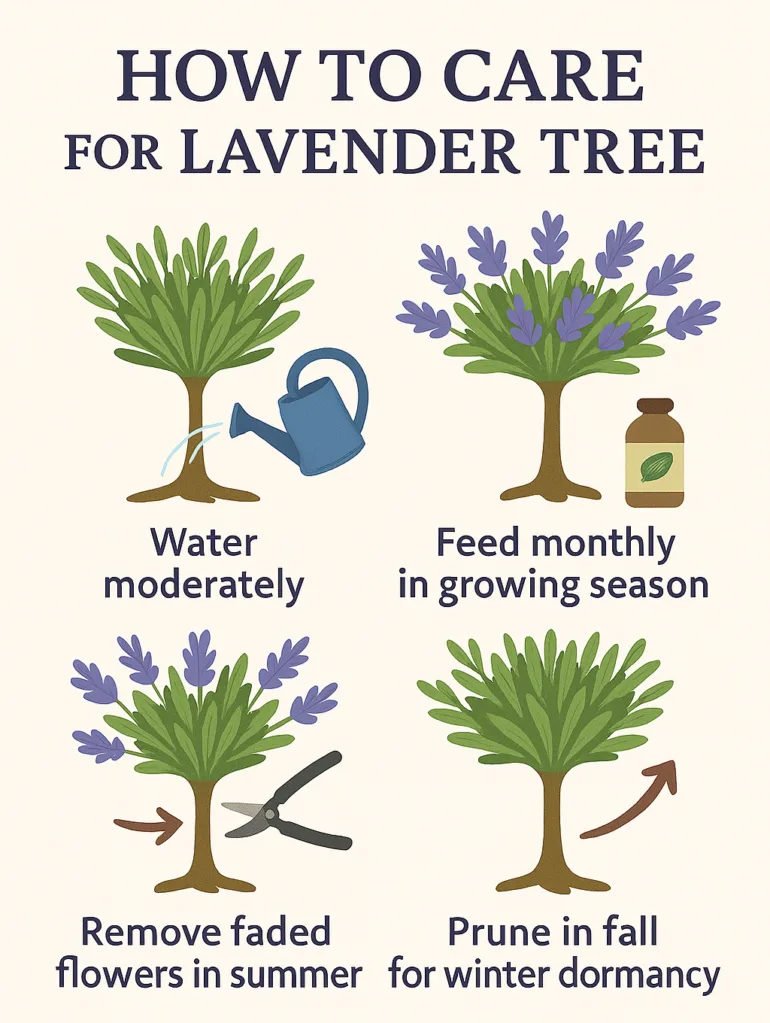Lavender, which is not just a fragrant shrub by the garden path, but a sophisticated tree with the scent of Provence and the character of a movie diva. And no, we are not talking about CGI, but a completely real plant that you can grow yourself - without a miracle fertilizer or a PhD in botany. It is a lavender tree!
If your balcony still looks like a warehouse for empty pots and forgotten flowerpots, tomatoes, then it's high time for an aesthetic upgrade. We present to you lavender tree – the plant equivalent of the little black dress: always chic, never boring.
This is not the one. classic lavender, who squats like a military orderly at the edge of the lawn. We are talking about the cultivated version – botanical aristocrats, which will add the charm of the South of France to your outdoor space and cause at least three compliments at the family barbecue.
Why would you even want a lavender tree?
Well, first of all, because it's beautiful. And it smells. And it's more low-maintenance than most indoor plants, which wither away in resentment if not looked at at least three times a day. A lavender tree won't force you into existential dilemmas about your own ability to care for life - it will simply thrive. And:
- loves the sun,
- hates excess water (who blames her?),
- and it will calm you with its scent better than any mindfulness app.
Choosing the right variety for lavender tree: beauties who can withstand anything
It all starts with genetics – or rather, with the right lavender variety. Don’t just jump at the first one you see in the garden store. Look for one that has the potential for a “tree career”:
- English lavender (Lavandula angustifolia): A classic among classics, cold-resistant, delicately scented, ideal for those who like to open their windows wide in winter.
- French lavender (Lavandula dentata): slightly more exotic, with curly leaves and restrained elegance – suitable for indoors or milder climates.
Regardless of the variety, choose a young specimen with one main stem. Because if you start with a bush, you'll end up with... well, a bush. A tree needs structure - and a little discipline.

The right planting: no drainage, no debate
Lavender and wet soil are like a couple on the verge of breaking up – it will take a while, but then the drama will follow. So make sure you have the optimal conditions:
- Pot with holesso that the water does not stand still.
- A layer of gravel or expanded clay at the bottom – because roots are not divers.
- Earth? Sandy, airy, almost meditative. Use a mix for cacti or Mediterranean herbs.
Watering? Only when the soil is dry to the first knuckle. Not on a schedule, but by feel – like with good coffee.
How a bush becomes a tree: a bonsai with a Mediterranean character
Now for the most zen part – the styling. Here, lavender transforms from a distracted herbal teenager into a dignified lady with a beautiful cleavage… sorry, crown.
Process:
- Remove all side shoots near the base.
- Leave only one main shoot – the future trunk.
- When it reaches a height of about 30–50 cm, start shaping the crown.
- Trim regularly, but with feeling. Like a hairdresser who knows what he's doing (and doesn't have a bad day).
Remove spent flowers after each bloom. It's not just aesthetic, it also makes biological sense - it encourages rebloom. And yes, your tree will bloom more than once a year. #Win
Light: without it there is no love
Lavender loves the sun. In fact, it wears shoes, to the point that without at least six hours of daylight it will look like it had a hard weekend. What if you have a shady balcony? You might want to consider ferns.
Indoors, a plant light helps. Or frequent moves between windows, but be prepared for envious glances from other pots.

Grooming: a routine that's not hard to love
Once you have your own tree, it's just a matter of loving routine:
- Watering: moderate. Lavender prefers dry to wet conditions.
- Fertilization: once a month during the growing season with a mild herb mix.
- Pruning: after flowering, without mercy.
- Winter protection: If it is in a pot, move it to a bright, cool place in winter. If it is left outside – wrap the pot in bubble wrap. Plants also like warm shoes.
A tree that is not just a plant – it is a statement
A lavender tree is not just an aesthetic addition. It is part of a lifestyle – a subtle statement that you know how to care for beauty and that you have an eye for detail. When you look out the window with your morning coffee and see your carefully shaped crown, you will know: this is a zen moment, without an app.
Why not earlier?
Seriously, why not? A little effort, a little soil, some sun – and voila, you have a fragrant tree that is not just Instagram material, but a true symbol of a better life.
And who knows, maybe this lavender will inspire you for another botanical adventure. Bonsai? Olives? Even a lemon tree? The world is your garden.






